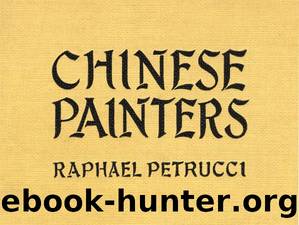Chinese Painters: A Critical Study by Raphaël Petrucci

Author:Raphaël Petrucci [Petrucci, Raphaël]
Language: eng
Format: epub
Tags: Painting -- China -- History, Painting, Chinese
Published: 2007-08-08T16:00:00+00:00
PLATE XVI. PORTRAIT OF A PRIEST
Yüan or Early Ming Period. Collection of H. Rivière.
As a landscape painter he seems to have worked in the style of the Southern School, with a fine, simple line in which may still be seen traces of the ancient tradition that extends back to Ku Kâai-chih. This characteristic line is found in the paintings of men and horses where the hand of Chao Mêng-fu is distinguishable. He bequeaths it to the large school which he founded, and, through his pupils, it becomes the inheritance of his imitators in the Ming period. It is more than probable that almost all of the paintings by his pupils, bearing the signature TzÅ-ang, are attributed to the master, while his own paintings are ascribed to Han Kan, painter of horses in the Tâang period. However, among the numerous works attributed to Chao Mêng-fu, there are a few in which we recognize the vibrant and flexible line which is seen in his landscapes. These paintings bear the signature of TzÅ-ang, in all probability a false one, but the work of art itself will always be of greater value in determining its authenticity than the most impressive of inscriptions. If the technique and the quality of the line are sufficiently similar to warrant attributing to the same hand the landscape in the British Museum, and any particular painting of horses, this may be regarded as sufficient evidence on which to base our own opinion as to his style.
Amongst his grooms and mounted soldiers, Chao Mêng-fu painted the different races which the wave of Mongolian invasion had swept into China: Chinese from the central provinces, Tartars, Mongols with fur caps, Moslems of a Semitic type from Turkestan, with white turbans and heavy earrings. Whether his subject was the little Tartar horse from the Mongolian plains or the beautiful steeds of ancient Transoxiana, always brought as tribute by way of Khotan to the Chinese court, he gave the life of the horse a singular beauty, portraying him in an equally happy manner whether in the act of racing or in the attitudes of repose. In his mind still dwelt the vision of Sung ideals, which proclaimed the hidden soul of things and valued spirituality and life in a painting. Although we see marked evidence of the Southern style in his work, his paintings are more strongly colored than are those of that school. The influence of the Yüan period begins to make itself felt. It brings out values in colored pigment, emphasizes its violence and paves the way for a new tradition.
Chao Mêng-fu has been compared by Chinese critics to his great predecessor Han Kan. The writings, however, are unanimous in stating that, notwithstanding his undeniable mastery, he lacked something of the vigor of the earlier master. When we attempt to compare the two styles through the aid of paintings of the Tâang period, wherein a reflection of the great animal painter may be sought, the writings appear to be confirmed in attributing
Download
This site does not store any files on its server. We only index and link to content provided by other sites. Please contact the content providers to delete copyright contents if any and email us, we'll remove relevant links or contents immediately.
Learn Drawing Quickly by Sharon Finmark(2089)
The Husband's Secret by Liane Moriarty(2041)
Drawing and Painting Birds by Tim Wootton(2001)
The Unlikely Pilgrimage of Harold Fry by Rachel Joyce(1836)
Classical Drawing Atelier by Juliette Aristides(1772)
One Drawing A Day by Veronica Lawlor(1494)
The Art of Creative Watercolor by Danielle Donaldson(1451)
Oil Painting For Dummies by Anita Marie Giddings & Sherry Stone Clifton(1395)
Anywhere, Anytime Art: Crayon by Monika Forsberg(1312)
Hieronymus Bosch by Virginia Pitts Rembert(1307)
Special Subjects: Basic Color Theory by Patti Mollica(1292)
Post-Impressionism by Nathalia Brodskaya(1285)
Woman's Mysteries by Esther Harding(1246)
Elizabeth Is Missing by Emma Healey(1231)
Memory's Wake by Fenech Selina(1183)
Fundamentals of Drawing by Barrington Barber(1058)
Acrylic Fusion by Dan Tranberg(1027)
Landscape Painting in Pastel by Elizabeth Mowry(1022)
Drawing by William Powell(999)
